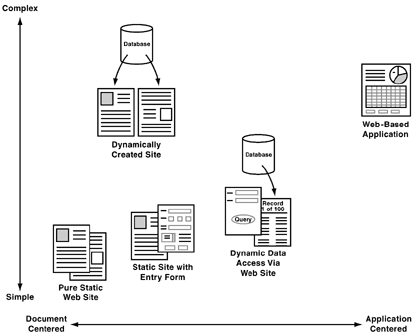












|
 |

Types of Web Sites
Users tend to view Web sites, and thus Web site design, by the function of the site or by its visual appearance. It is important to be able to describe sites this way; however, there are many more ways to categorize them. While the possible categories of sites may appear endless, we can safely group sites in a few general ways. We'll start first with the abstract and then move to visual categorizations.
Abstract Groupings
First, consider if a site is information focused or task focused. Sometimes we may describe this distinction as one between a site that is document-centered and one that is application-centered. Document-centered or informational sites provide information for users, but they provide very limited interactivity (other than allowing the user to browse, search, or sort the information presented). Sites that are task or applications oriented allow the user to interact with information or accomplish some task, such as transferring funds from a bank account or buying a new sweater. Hybrid sites do a little of both; these are becoming more common as the line between information and application blurs. Figure 1-3 plots the continuum from a simple static document-oriented site (often called a "brochureware" site) to full-blown software applications. This abstract grouping suggests that there is a transition from more document- or print-oriented Web sites to more interactive programmatic Web sites. This is indeed true; the intersection between the two philosophical camps is a source for much of the contention—and innovation—in the Web design community.
 |
| Figure 3: The range of Web sites |
Another way we might group sites is within the following broad categories:
- Informational sites These sites provide information about a particular subject or organization (the "brochureware" sites). These are the most common Web sites on the Internet and often take on aspects of the other site categories over time.
- Transactional sites This type of site can be used to conduct some transaction or task. E-commerce sites fall into this category.
- Community sites These provide information or transaction-related facilities, but focus on the interaction between the visitors of the site. Community-based sites tend to focus on a particular topic or type of person and encourage interaction between likeminded individuals.
- Entertainment sites These sites are for game playing or some form of amusing interaction, which may include transactional, community, and informational elements.
- Other sites Included here are artistic or experimental sites, personal Web spaces such as Web logs (also called blogs), and sites that may not follow common Web conventions or have a well-defined economic purpose.
We might also group sites based upon the organization that is running, or in some sense paying for, the site. Within this type of categorization we see five major groupings:
- Commercial These sites provide information about a particular subject or organization (the "brochureware" sites). These are the most common Web sites on the Internet and often take on aspects of the other site categories over time.
- Government This type of site can be used to conduct some transaction or task. E-commerce sites fall into this category.
- Educational These provide information or transaction-related facilities, but focus on the interaction between the visitors of the site. Community-based sites tend to focus on a particular topic or type of person and encourage interaction between likeminded individuals.
- Charitable These sites are for game playing or some form of amusing interaction, which may include transactional, community, and informational elements.
- Personal Included here are artistic or experimental sites, personal Web spaces such as Web logs (also called blogs), and sites that may not follow common Web conventions or have a well-defined economic purpose.
Categorization can be difficult. For example, educational sites might really fall under the governmental category. Some sites in the personal category may arguably belong in the charitable or commercial group, depending on the reason for the person putting the site together. Now we turn to the more visual characteristics of sites, with a few sample categories of sites commonly seen on the Web.
|




